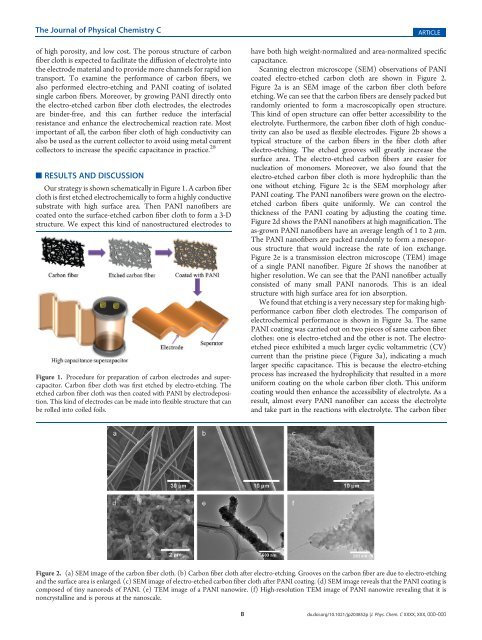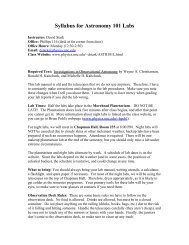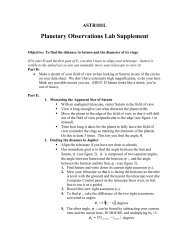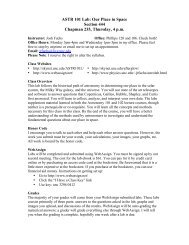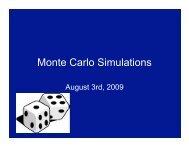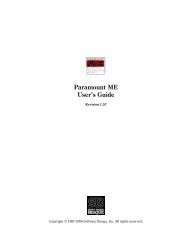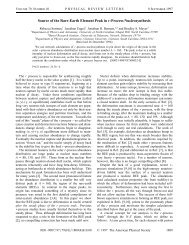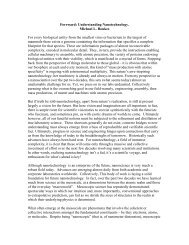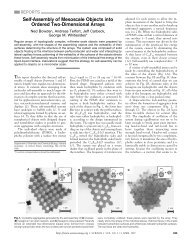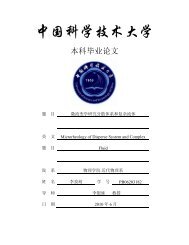Polyaniline-Coated Electro-Etched Carbon Fiber Cloth Electrodes ...
Polyaniline-Coated Electro-Etched Carbon Fiber Cloth Electrodes ...
Polyaniline-Coated Electro-Etched Carbon Fiber Cloth Electrodes ...
Create successful ePaper yourself
Turn your PDF publications into a flip-book with our unique Google optimized e-Paper software.
The Journal of Physical Chemistry C<br />
of high porosity, and low cost. The porous structure of carbon<br />
fiber cloth is expected to facilitate the diffusion of electrolyte into<br />
the electrode material and to provide more channels for rapid ion<br />
transport. To examine the performance of carbon fibers, we<br />
also performed electro-etching and PANI coating of isolated<br />
single carbon fibers. Moreover, by growing PANI directly onto<br />
the electro-etched carbon fiber cloth electrodes, the electrodes<br />
are binder-free, and this can further reduce the interfacial<br />
resistance and enhance the electrochemical reaction rate. Most<br />
important of all, the carbon fiber cloth of high conductivity can<br />
also be used as the current collector to avoid using metal current<br />
collectors to increase the specific capacitance in practice. 28<br />
’ RESULTS AND DISCUSSION<br />
Our strategy is shown schematically in Figure 1. A carbon fiber<br />
cloth is first etched electrochemically to form a highly conductive<br />
substrate with high surface area. Then PANI nanofibers are<br />
coated onto the surface-etched carbon fiber cloth to form a 3-D<br />
structure. We expect this kind of nanostructured electrodes to<br />
Figure 1. Procedure for preparation of carbon electrodes and supercapacitor.<br />
<strong>Carbon</strong> fiber cloth was first etched by electro-etching. The<br />
etched carbon fiber cloth was then coated with PANI by electrodeposition.<br />
This kind of electrodes can be made into flexible structure that can<br />
be rolled into coiled foils.<br />
ARTICLE<br />
have both high weight-normalized and area-normalized specific<br />
capacitance.<br />
Scanning electron microscope (SEM) observations of PANI<br />
coated electro-etched carbon cloth are shown in Figure 2.<br />
Figure 2a is an SEM image of the carbon fiber cloth before<br />
etching. We can see that the carbon fibers are densely packed but<br />
randomly oriented to form a macroscopically open structure.<br />
This kind of open structure can offer better accessibility to the<br />
electrolyte. Furthermore, the carbon fiber cloth of high conductivity<br />
can also be used as flexible electrodes. Figure 2b shows a<br />
typical structure of the carbon fibers in the fiber cloth after<br />
electro-etching. The etched grooves will greatly increase the<br />
surface area. The electro-etched carbon fibers are easier for<br />
nucleation of monomers. Moreover, we also found that the<br />
electro-etched carbon fiber cloth is more hydrophilic than the<br />
one without etching. Figure 2c is the SEM morphology after<br />
PANI coating. The PANI nanofibers were grown on the electroetched<br />
carbon fibers quite uniformly. We can control the<br />
thickness of the PANI coating by adjusting the coating time.<br />
Figure 2d shows the PANI nanofibers at high magnification. The<br />
as-grown PANI nanofibers have an average length of 1 to 2 μm.<br />
The PANI nanofibers are packed randomly to form a mesoporous<br />
structure that would increase the rate of ion exchange.<br />
Figure 2e is a transmission electron microscope (TEM) image<br />
of a single PANI nanofiber. Figure 2f shows the nanofiber at<br />
higher resolution. We can see that the PANI nanofiber actually<br />
consisted of many small PANI nanorods. This is an ideal<br />
structure with high surface area for ion absorption.<br />
We found that etching is a very necessary step for making highperformance<br />
carbon fiber cloth electrodes. The comparison of<br />
electrochemical performance is shown in Figure 3a. The same<br />
PANI coating was carried out on two pieces of same carbon fiber<br />
clothes: one is electro-etched and the other is not. The electroetched<br />
piece exhibited a much larger cyclic voltammetric (CV)<br />
current than the pristine piece (Figure 3a), indicating a much<br />
larger specific capacitance. This is because the electro-etching<br />
process has increased the hydrophilicity that resulted in a more<br />
uniform coating on the whole carbon fiber cloth. This uniform<br />
coating would then enhance the accessibility of electrolyte. As a<br />
result, almost every PANI nanofiber can access the electrolyte<br />
and take part in the reactions with electrolyte. The carbon fiber<br />
Figure 2. (a) SEM image of the carbon fiber cloth. (b) <strong>Carbon</strong> fiber cloth after electro-etching. Grooves on the carbon fiber are due to electro-etching<br />
and the surface area is enlarged. (c) SEM image of electro-etched carbon fiber cloth after PANI coating. (d) SEM image reveals that the PANI coating is<br />
composed of tiny nanorods of PANI. (e) TEM image of a PANI nanowire. (f) High-resolution TEM image of PANI nanowire revealing that it is<br />
noncrystalline and is porous at the nanoscale.<br />
B dx.doi.org/10.1021/jp203852p |J. Phys. Chem. C XXXX, XXX, 000–000


